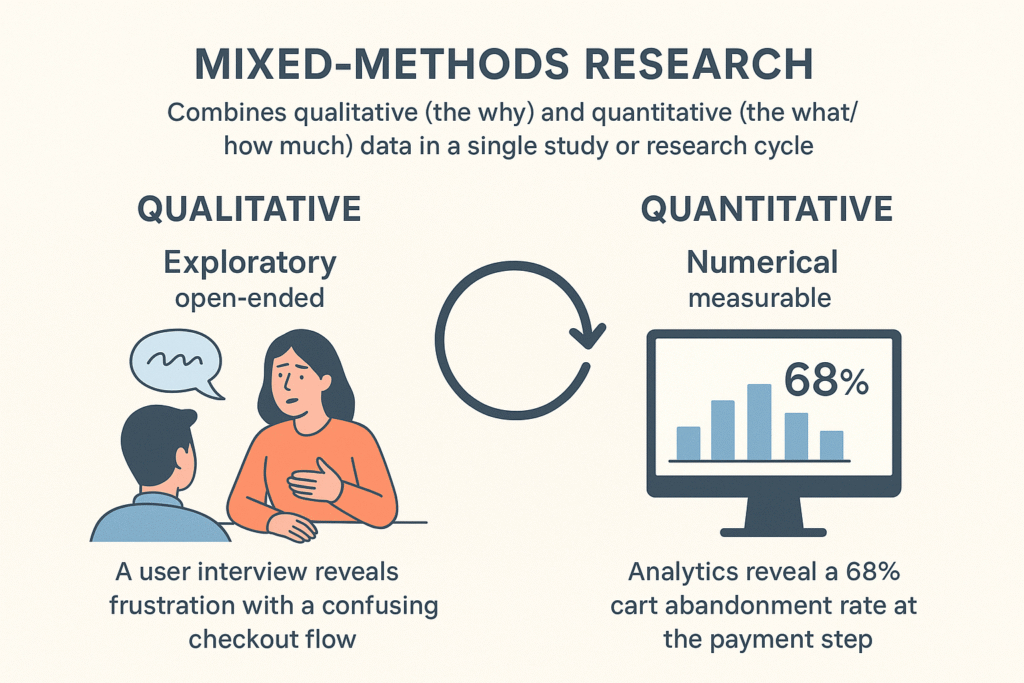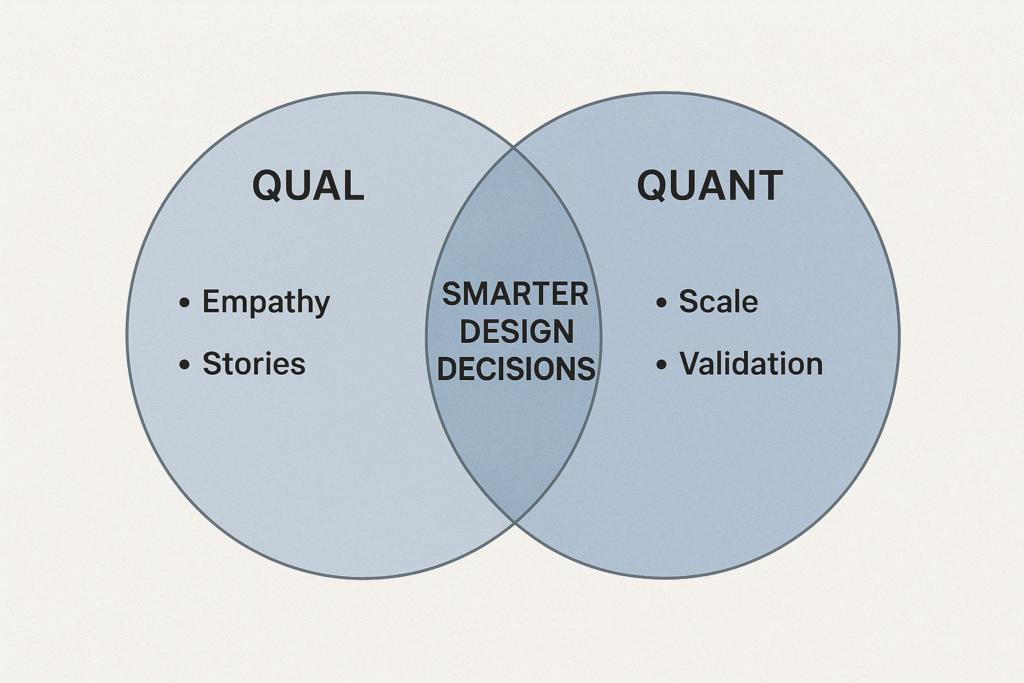Master Mixed-Methods Research with Online UX Design Training
Discover how mixed-methods research combines qualitative and quantitative insights to make smarter UX design decisions. This online UX design training course teaches practical techniques for analyzing user behavior, uncovering pain points, and validating solutions.
Ideal for UX designers, this course provides hands-on training to apply stories and numbers together, helping you confidently design human-centered experiences that solve real problems.
Imagine you’re developing a new app. You know what people do (they tap this button, they abandon the checkout process), but you don’t know why. You have the “what” from your analytics, but you’re missing the crucial “why” from user feedback.
This is the classic dilemma in user research. On one side, you have quantitative data—the numbers. Think website analytics, survey results, and A/B test data. It’s fantastic for telling you what is happening at scale. On the other side is qualitative data—the stories. This comes from usability testing, user interviews, and field studies, and it’s essential for understanding the why behind user behavior.
So, what’s the solution? You don’t have to choose one or the other. By blending these two approaches, you can create a powerful synergy that gives you a complete, 360-degree view of your users. This is mixed-methods research, and it’s the key to making smarter, more confident design decision
What is Mixed-Methods Research?

Mixed-methods research combines qualitative (the why) and quantitative (the what/how much) data in a single study or research cycle.
- Qualitative = Exploratory, open-ended. Uncovers why users behave the way they do. Example: a user interview reveals frustration with a confusing checkout flow.
- Quantitative = Numerical, measurable. Shows what’s happening at scale. Example: analytics reveal a 68% cart abandonment rate at the payment step.
Together, they give you both context and scale: the story and the proof.
When to Use Mixed-Methods Research
Here are three common scenarios:
- Before a Redesign
- Use interviews and usability tests to uncover pain points.
- Validate findings with surveys or analytics to see how widespread the issues are.
- Use interviews and usability tests to uncover pain points.
- Testing New Features
- Run a usability test to watch people interact with a prototype.
- Pair it with an A/B test to measure which version improves task completion.
- Run a usability test to watch people interact with a prototype.
- Making Business Cases
- Storytelling alone rarely convinces stakeholders.
- Numbers without stories lack empathy.
- Combining both helps you argue for changes with evidence and impact.
- Storytelling alone rarely convinces stakeholders.

A Practical Guide to Blending Qual & Quant
You might be wondering how to actually do this. The beauty of mixed-methods research is its flexibility. Here are three common approaches to get you started:
1. The Exploratory Approach (Qualitative First)
This method starts with qualitative research to uncover insights, which are then used to build a quantitative study.
- Step 1: Discover the “Why.” Conduct in-depth user interviews, ethnographic studies, or diary studies. You’re looking for surprising behaviors, pain points, and unmet needs.
- Step 2: Quantify the Findings. Use the themes and hypotheses you discovered to create a large-scale survey or a card-sorting exercise. This helps you validate your qualitative findings across a broader audience.
Example: A Retail App’s Checkout Problem A UX team noticed from their analytics that many users were abandoning their shopping carts right before the final payment step. They first conducted user interviews with a handful of users who had recently abandoned their carts. The interviews revealed that users were confused by unexpected shipping fees and a lack of guest checkout options.
Armed with this qualitative insight, the team created a survey. They asked hundreds of users to rate the importance of transparent shipping costs and guest checkout. The survey data confirmed that these issues were widespread and highly important to their user base, providing the definitive evidence needed to justify a redesign.
2. The Explanatory Approach (Quantitative First)
This method starts with quantitative data to identify a problem, and then uses qualitative research to understand why it’s happening.
- Step 1: Spot the Trend. Look for unusual patterns in your analytics, survey results, or A/B test data.
- Step 2: Dig Deeper. Conduct usability testing or follow-up interviews with the specific user segments identified in your quantitative analysis. Watch them interact with your product to understand their thought process and motivations.
Example: A News Website’s Low Engagement a content team saw that an article series on their news site had high traffic but unusually low “time on page” compared to other articles. The quantitative data showed a clear problem: people were clicking but not reading.
To understand why, they conducted usability testing. They asked users to read the articles while thinking out loud. The testing revealed a key issue: the articles’ formatting was dense and hard to skim on mobile devices. Users felt overwhelmed and left quickly. The qualitative feedback provided the crucial context that the numbers alone couldn’t.
3. The Convergent Approach (Running Qual & Quant in Parallel)
In this approach, you conduct both types of research at the same time and then compare the results to see if they corroborate each other.
- Step 1: Simultaneous Studies. Run an unmoderated usability test with a large group of users while also conducting in-depth interviews with a smaller group.
- Step 2: Cross-Reference. Look for themes that appear in both data sets. Does the behavior you see in the quantitative test match the stories you hear in the interviews? This triangulation strengthens your conclusions.
A Framework for Better Research
To ensure you’re getting the most out of mixed-methods research, follow this simple framework.
1. Define Your Question: Start with a clear, specific research question. Is it about what’s happening (quantitative) or why it’s happening (qualitative)? The answer will guide your first step.
2. Plan Your Approach: Choose one of the strategies above (Exploratory, Explanatory, or Convergent). What data do you need first to build on your next step?
3. Collect and Analyze: Gather your data. Look for trends in the quantitative data and themes in the qualitative data.
4. Synthesize Your Findings: This is the most crucial step. Bring your data together. Do the numbers support the stories? Do the stories explain the numbers? Don’t be afraid to go back and get more data if something doesn’t align.
5. Take Action: Use your combined insights to make confident ux design decisions. You can now tell stakeholders not only that a problem exists, but also why it exists, and how to fix it. This is how you move from simply reporting data to driving meaningful change
Tips for Applying Mixed Methods in Your Work
- Start small. You don’t need a massive budget. Even pairing 5 usability tests with one short survey can be powerful.
- Use existing data. Analytics and past research can complement new qualitative findings.
- Align with stakeholders. Present qual quotes and quant graphs together—this makes research hard to ignore.
- Iterate often. Don’t treat mixed methods as a one-off. Make it a habit in your design cycle.
Key Takeaways
- Qual tells you why. Quant tells you how much. Both are necessary.
- Mixed-methods research reduces bias and gives a more complete understanding of user behavior.
- It’s practical. Even small teams can use it to make confident design decisions.
- Stories + Numbers = Impact. This combination helps you win buy-in from stakeholders and ensures your design truly works for people.
Conclusion: Smarter, Human-Centered Decisions
In UX, the goal isn’t just to build usable interfaces. It’s to design experiences that solve real problems for real people—and to back those decisions with evidence that convinces stakeholders.
Mixed-methods research is your bridge between empathy and evidence. It ensures you’re not just guessing, not just counting clicks, but making design decisions that matter. Xperience Wave offers an online UX training program designed specifically to provide practical knowledge, real-world projects, and guidance tailored for experienced learners.


